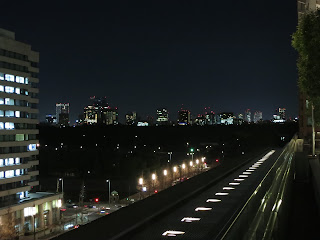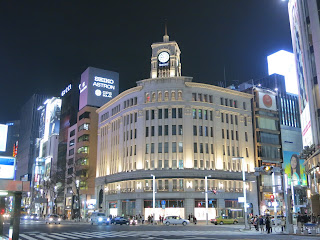The island of Odaiba is a rectangular thumb of land set within Tokyo Bay. Many visitors to Japan, and Tokyo in particular might notice it in one or two books, but never on any itinerary, and that's a shame. Odaiba is one of the most open areas of the city, with vast, empty green spaces of lawns set between buildings and arcitecture of very unusual quality. Created out of the economic book of the eighties and nineties, Odaiba attracted unusual from the start, and to this day it remains an eclectic place for the eccentric to visit.
Odaiba is a paradise for otaku, those fans of Japanese anime, video games and pop culture. Next to Akihabara, its probably the best location to visit for otaku in Tokyo. There are huge indoor malls, like something out of Las Vegas with their decor, a massive video arcade theme park called Joyopolis and much much more. For the fan of buildings Odaiba is ultra modern, almost futuristic in the design of the buildings that lie scattered around it. Several are well known like the FujiTV building, with its latticework and huge sphere, or the BigSight with its inverse pyramids.
 |
| Add caption |
I grew up with a love of Japan and Japanese culture, but I never considered myself an Otaku. Anime, manga, I wasn't aware of them or wasn't a fan. I enjoyed some of the cartoons that came over to the USA in the 1990's and thereafter. One of the images cemented in my head from that time of first discovering anime was the Fuji TV building. Its a very unique structure, nothing else quite like it in the world. From the outside its a latticework of steel and glass, with a large, slightly off-center sphere in the middle.
I don't know why, but this building brings a deep sense of nostalgia. I remember seeing it in a few Anime when I was a kid, thinking to myself, such a place cant exist. Well, here it was before me, on Odaiba. A few other people were around, snapping pictures, probably feeling the same nostalgia. All were foreigners, just like me. Some of us probably had memories of large, digital monsters, who used the sphere of this building as a volley ball in the Digimon Anime that came out in the 90's.
This lack of development lends itself to another unique part about Odaiba. I mentioned its open, with lots of greenways, empty spaces, and not so many people. That could be quite a draw in itself. When you walk through Tokyo and its buildings packed on top of buildings, packed on top of people, it gets old quick. Going underground to get anywhere also gets old, so having a train above ground, to an open place with not so many people is refreshing.
Odaiba also has spectacular views of the city. One needs only go a hundred yards from the Fuji Building to see Skytree, Rainbow Bridge, and parts of Shinjuku or Shibuya. A small scale replica of the Statue of Liberty stands here, for what reason I don't know. It's a great place to stand and get a panorama shot of the bay and the city.
Odaiba isn't lacking in food either. One needs only duck into the dozen or so malls that dot the island and find a plethora of options. The malls are ventures into themselves, sometimes loud, obnoxious on the inside. The VenusFort in one part has an interior like Venice, with painted ceilings, fountains and other weird decorations. We were hungry, and found a nice little yakkitori joint inside a mall right next to FujiTV. Having a bowl of soup, with rice and roasted chicken on a cold afternoon was a pleasant diversion. Didn't hurt we had great views of FujiTV out the window.
I wanted to meander the mall, see what I could find, but the day was already getting late and my parents were tired. I decided I would visit the one other feature I -had- to see on odaiba.
Japan is known for many things to the casual westerner: Godzilla, Speed Racer, car brands, etc. It's also known for giant fighting robots. Well, one needs only travel to Odaiba to see one of these in person, standing outside the DiverCity Mall.
This is the Gundam, a 1.1 scale model of a mobile suit robot from a popular anime from the 90's in Japan and the USA. It stands, stoic, as if it just landed, and its pilot had climbed out to hop inside the nearby building to get some ramen. The robot is just a statue, albeit one with a moving head, but for me, it was another trip down the nostalgia of my childhood.
This statue is huge, and incredibly detailed. One doesn't really get a sense of the size of it until your standing about a meter away, looking up. It towers over everything, and looks like it might spring to life at any moment and bust a laser sword through a building.

There is much more to see on Odaiba, but we were tired by that point and didn't have a chance. You have a sense of the scope of scale here because of the open spaces. Indeed, its a breath of fresh air, a different sense of culture shock to have that openness from the crowded areas around Tokyo Station or elsewhere. I have to give my parents credit for hanging tough as tired as they were. I think they enjoyed the island for a reason other than nostalgia though. For them that breath of openness breathed new life after a busy day. After all, we'd ascended the heights of Tokyo Skytree, walked to Asakusa with its crowds, and then we traveled to an island in the bay just so I could live a nostalgia trip. On the whole, a busy but a good day. That night was their anniversary, and I was about to share a very special dinner with my parents.























































